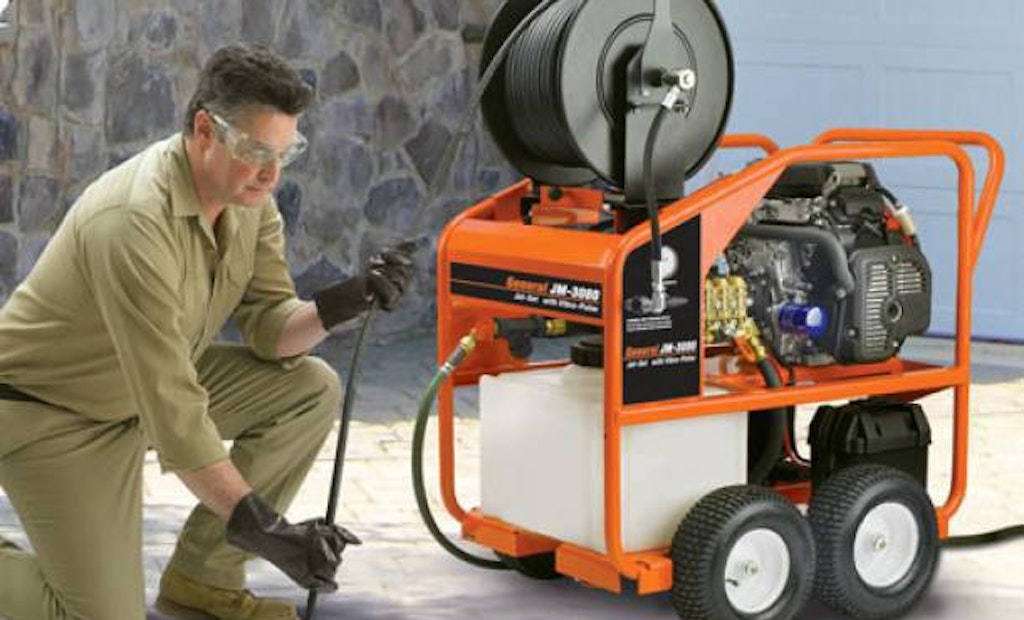Interested in Cleaning?
Get Cleaning articles, news and videos right in your inbox! Sign up now.
Cleaning + Get Alerts“I don’t know what we did before water jets,” says George Bauer of Bauer Plumbing. “They just blow everything away.”
For grease, sand and ice, nothing clears the line faster than a jet. High-pressure water jets have been hot among the professional drain cleaners for years.
When a drain cleaning cable goes through grease, the grease will close up behind the cable and still leave the line clogged. A water jet flushes away sticky clogs like grease that cable machines have a hard time clearing. They use a stream of high-pressure water that hits the stoppage and flushes it away. The thrust of the nozzle drives the hose down the line and gives you wall-to-wall cleaning action.
“We use a camera system after the line has been jetted and the drain pipes look as good as new,” says Bob Garbutt of Pipeline Mechanical. “You can actually read the writing on the walls of the pipe.”
Jets do not replace cable machines. Rather, each have specific advantages — jets handle grease, sand and ice but cannot clear heavy stoppages like tree roots. Jets do not replace cable machines; rather, each compliments the other nicely.
“We use both. Both have their applications,” says Greg Collins of Collins Plumbing. “But basically, if you’re going to be dealing with grease — the fast food industry and retail — the jetter is the only way to go.”
If you are in a cold climate, jets can be used to clear lines clogged with ice. The larger gas jets can clear a foot of ice per minute in a 4-inch line.
Jets are available in both electric and gas drive models. The most pressure you can get from an electric jet without worrying about popping breakers is 1,500 psi at about 2 gallons per minute. This combination can handle most inside lines between 1.5 inches to 4 inches up to 150 feet long, but is not powerful enough to do a satisfactory job in main lines.
For outside lines up to 10 inches in diameter and up to 600 feet long, a gas drive jet will provide the pressure and flow rate (3,000 psi at 4 to 5.5 gpm) required to do the job well.
“I rarely use the electric jet anymore because the gas jet is so powerful it blows everything away,” said Bauer. “We’ll use the electric on small lines or in an apartment building, but we use the gas for everything else — inside or out.”
How does Bauer use a gas jet on an inside job? He leaves the gas jet outside and pulls the jet hose into the basement or up on the roof of the home. He then hooks it up to a portable reel with a smaller diameter hose to handle the inside lines. The exhaust is safely outside while the high pressure of a gas jet is at work inside. Some plumbers mount the jet permanently in their truck and vent the exhaust to the outside.
Restaurants, factories and institutions where grease clogs are a constant problem are ideal for jets. If you can set up a maintenance contract with likely customers in your area, the jet can pay for itself in just a few months. Contact the restaurants and tell them you can prevent a clogged drain on a busy Saturday night when the waiting line is out the door. Instead, you come on a slow Monday every other month before the clog occurs.
Collins talked about the time he demonstrated a jet to a customer who thought his restaurant’s lines had been cleaned by a cable machine just two weeks before.
“We had the head of their maintenance department there and we pulled out a log of grease probably about 1.5 inches in diameter and about 2 feet long, and he was very impressed with that,” says Collins.
To impress your customers, Collins has this advice, “What we do is keep a bucket, a couple-of-gallon pail, and just keep the grease for our customers and show them, just so they know what the jet is doing.”
When you’re buying a jet, make sure it has a pulsation device — it makes the hose vibrate to overcome the friction in the line so the hose will slide easily around bends and go longer distances. Without it, the hose is very likely to get stuck. Your machine should also have a backflow prevention device to prevent sewer water from getting into the fresh water supply. Jet nozzles should be hardened stainless steel rather than brass, as they will last longer and withstand the abuse of cast iron pipe.
“Our annual sales from our water jets are approximately $50,000, which is approximately $1,000 gross revenue each week coming off a piece of equipment that we consider to be a very good investment as far as our company is concerned,” says Garbutt. “We’ve found the need to have a second water jet because we’ve got a reputation for using this piece of equipment now and the satisfactory results that have come off of using the jets. We used to allow two days to do mains and horizontals in a building. Now we allow one day and charging the same price as two.”
A sound investment in any book.






